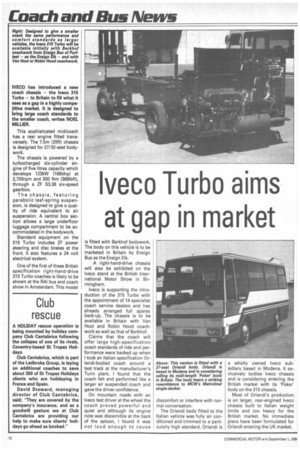Iveco Turbo aims at gap in market
Page 14

If you've noticed an error in this article please click here to report it so we can fix it.
IVECO has introduced a new coach chassis — the Ivaco 315 Turbo — to Britain to fill what it sees as a gap in a highly competitive market. It is designed to bring large coach standards to the smaller coach, writes NOEL MILLIER.
This sophisticated midicoach has a rear engine fitted transversely. The 7.5m (25ft) chassis is designed for 27/32-seat bodywork.
The chassis is powered by a turbocharged six-cylinder engine of five litres capacity which develops 123kW (168bhp) at 2,700rpm and 500 Nm (3691bft), through a ZF S3.36 six-speed gearbox.
The chassis, featuring parabolic leaf-spring suspension, is designed to give a quality of ride equivalent to air suspension. A central box section allows a large underfloor luggage compartment to be accommodated in the bodywork.
Standard equipment on the 315 Turbo includes ZF power steering and disc brakes at the front. It also features a 24 volt electrical system.
One of the first of these British specification right-hand-drive 315 Turbo coaches is likely to be shown at the RAI bus and coach show in Amsterdam. This model is fitted with Berkhof bodywork. The body on this vehicle is to be marketed in Britain by Ensign Bus as the Ensign Elk.
A right-hand-drive chassis will also be exhibited on the Iveco stand at the British International Motor Show in Birmingham.
Iveco is supporting the introduction of the 315 Turbo with the appointment of 14 specialist coach service dealers and has already arranged full spares back-up. The chassis is to be available in Britain with Van Hod l and Robin Hood coachwork as well as that of Berkhof.
Claims that the coach will offer large high-specification coach standards of ride and performance were backed up when I took an Italian specification Orlandi-bodied coach around a test track at the manufacturer's Turin plant. I found that the coach felt and performed like a larger air suspended coach and gave the driver confidence.
On mountain roads with an lveco test driver at the wheel the coach proved powerful and quiet and although its engine note was discernible at the back of the saloon, I found it was not loud enough to cause discomfort or interfere with normal conversation.
The Orlandi body fitted to the Italian vehicle was fully air conditioned and trimmed to a particularly high standard, Orlandi is a wholly owned Iveco subsidiary based in Modena. It exclusively bodies Iveco chassis and is considering entering the British market with its 'Poker' body on the 315 chassis.
Most of Orlandi's production is on larger, rear-engined Iveco chassis built to Italian weight limits and too heavy for the British market. No immediate plans have been formulated for Orlandi entering the UK market.




















































































